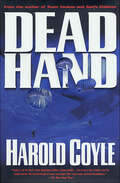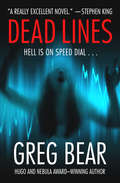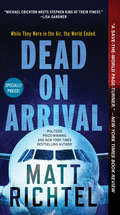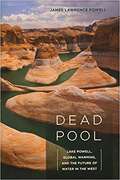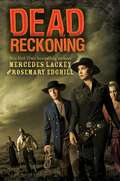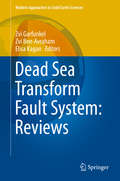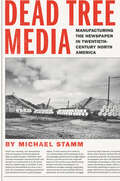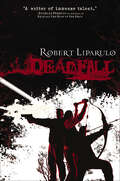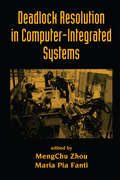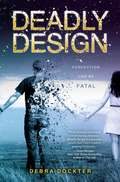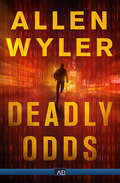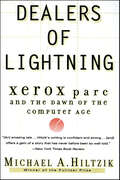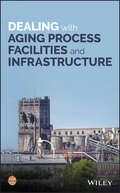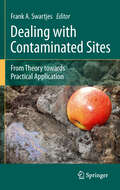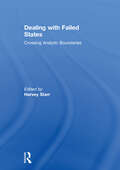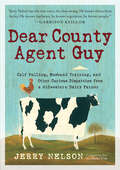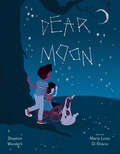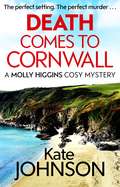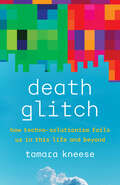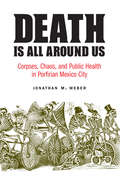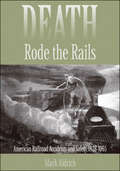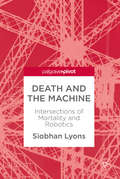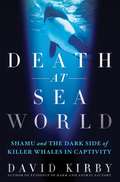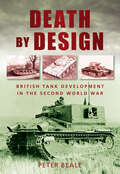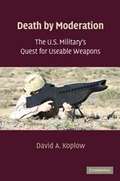- Table View
- List View
Dead Hand
by Harold CoyleWhen an unforeseen asteroid strikes Siberia with the force of a thousand Hiroshimas, it triggers Dead Hand, the ultimate defense mechanism developed by the Soviets at the height of the Cold War.The missiles are pointing at the United States and its European allies, and ultra-nationalist General Likatchev is willing to use them as blackmail to topple the government in Moscow and return Russia to her status as world power. When Russia responds to world queries with cold silence, a NATO special operations unit is dropped into Siberia. Trapped in a region ravaged by freezing snow and the hellish aftermath of the asteroid impact, the NATO forces are racing against time to track down Likatchev and dismantle Dead Hand before a global holocaust is unleashed.At the Publisher's request, this title is being sold without Digital Rights Management Software (DRM) applied.
Dead Lines: Hell Is On Speed Dial ...
by Greg BearFrom a New York Times–bestselling author: A new kind of phone awakens the dead in this technological horror novel &“reminiscent of Koontz at his best&” (Booklist). Ever since his life was shattered by the kidnapping and murder of his young daughter, Peter Russell has become a ghost of a man. Once a successful director of adult films, he has been reduced to running questionable errands for an eccentric California millionaire. But everything changes when a Los Angeles start-up offers him the opportunity to create promotional videos for their revolutionary new technology, Trans. The product offers exceptionally powerful, crystal-clear mobile communication that can operate anywhere and everywhere—and Peter sets out to put it into every palm. But as he uses the device himself, he starts to see his murdered little girl . . . Soon, there are other voices—disembodied, confused, angry—emanating from a newly invaded dimension. Many are even malevolent . . . and hungry . . . and deadly. As the death toll of Trans-users skyrockets, Peter&’s life begins a new spiral downward. Now, he must race to make sense of the horror Trans has wrought before the gateway to Hell bursts wide open. With Dead Lines, author of the Eon series Greg Bear transforms the literary realm of Dean Koontz, Peter Straub, and Stephen King into something unique by ingeniously blending the speculative with the supernatural. You&’ll never look at your phone the same way again.
Dead On Arrival: A Novel
by Matt Richtel“MICHAEL CRICHTON meets STEPHEN KING at their finest … with the creepiest opening I’ve ever read.” — Lisa Gardner * “Joins the ranks of classic paranoid thrillers about human achievement run amok, with STEPHEN KING’s The Stand and Michael Crichton’s Terminal Man.” — Joseph Finder * “A heart-stopping thriller. … a must-read for MICHAEL CRICHTON fans.” — Dallas Morning News * “Similar in atmosphere and style to MICHAEL CRICHTON and STEPHEN KING. ... A race-against-the-clock thriller.” — BooklistFLIGHT 194 LANDED.SOMETHING LETHAL AWAITS OUTSIDE.THIS IS DEAD ON ARRIVAL.An airplane touches down at a desolate airport in a remote Colorado ski town. Shortly after landing, Dr. Lyle Martin, a world-class infectious disease specialist, is brusquely awakened to shocking news: Everyone not on the plane appears to be dead. The world has gone dark. While they were in the air, a lethal new kind of virus surfaced, threatening mankind's survival, and now Martin—one of the most sought-after virologists on the planet until his career took a precipitous slide—is at the center of the investigation.Moving at lightning pace from the snowbound Rockies to the secret campus of Google X, where unlimited budgets may be producing wonders beyond our capacity to control, Dead on Arrival is a brilliantly imaginative, intricately plotted thriller that draws on Matt Richtel's years of science and technology reporting for the New York Times, and establishes him as one of the premier thriller writers working today.
Dead Pool: Lake Powell, Global Warming, And The Future Of Water In The West
by James Lawrence PowellWhere will the water come from to sustain the great desert cities of Las Vegas, Los Angeles, and Phoenix? In a provocative exploration of the past, present, and future of water in the West, James Lawrence Powell begins at Lake Powell, the vast reservoir that has become an emblem of this story. At present, Lake Powell is less than half full. Bathtub rings ten stories tall encircle its blue water; boat ramps and marinas lie stranded and useless. To refill it would require surplus water―but there is no surplus: burgeoning populations and thirsty crops consume every drop of the Colorado River. Add to this picture the looming effects of global warming and drought, and the scenario becomes bleaker still. Dead Pool, featuring rarely seen historical photographs, explains why America built the dam that made Lake Powell and others like it and then allowed its citizens to become dependent on their benefits, which were always temporary. Writing for a wide audience, Powell shows us exactly why an urgent threat during the first half of the twenty-first century will come not from the rising of the seas but from the falling of the reservoirs.
Dead Reckoning
by Rosemary Edghill Mercedes LackeyJett is a girl disguised as a boy, living as a gambler in the old West as she searches for her long-lost brother. Honoria Gibbons is a smart, self-sufficient young woman who also happens to be a fabulous inventor. Both young women travel the prairie alone - until they are brought together by a zombie invasion! As Jett and Honoria investigate, they soon learn that these zombies aren't rising from the dead of their own accord ... but who would want an undead army? And why? This gunslinging, hair-raising, zombie western mashup is perfect for fans ofCowboys vs. Aliens and Pride & Prejudice & Zombies.
Dead Sea Transform Fault System: Reviews
by Zvi Garfunkel Zvi Ben-Avraham Elisa KaganThe Dead Sea transform is an active plate boundary connecting the Red Sea seafloor spreading system to the Arabian-Eurasian continental collision zone. Its geology and geophysics provide a natural laboratory for investigation of the surficial, crustal and mantle processes occurring along transtensional and transpressional transform fault domains on a lithospheric scale and related to continental breakup. There have been many detailed and disciplinary studies of the Dead Sea transform fault zone during the last 20 years and this book brings them together. This book is an updated comprehensive coverage of the knowledge, based on recent studies of the tectonics, structure, geophysics, volcanism, active tectonics, sedimentology and paleo and modern climate of the Dead Sea transform fault zone. It puts together all this new information and knowledge in a coherent fashion.
Dead Tree Media: Manufacturing the Newspaper in Twentieth-Century North America (Hagley Library Studies in Business, Technology, and Politics)
by Michael StammA deep and timely account of how American newspapers were produced and distributed on paper.Winner of the Best Book in Canadian Business History by the Canadian Business History AssociationPopular assessments of printed newspapers have become so grim that some have taken to calling them "dead tree media" as a way of invoking the medium’s imminent demise. There is a literal truth hidden in this dismissive expression: printed newspapers really are material goods made from trees. And, throughout the twentieth century, the overwhelming majority of trees cut down in the service of printing newspapers in the United States came from Canada. In Dead Tree Media, Michael Stamm reveals the international history of the commodity chains connecting Canadian trees and US readers. Drawing on newly available corporate documents and research in archives across North America, Stamm offers a sophisticated rethinking of the material history of the printed newspaper. Tracing its industrial production from the forest to the newsstand, he provides an account of the obscure and often hidden labor involved in this manufacturing process by showing how it was driven by not only publishers and journalists but also lumberjacks, paper mill workers, policymakers, chemists, and urban and regional planners. Stamm describes the 1911 shift in tariff policy that gave US publishers duty-free access to Canadian newsprint, providing a tremendous boost to Canadian paper manufacturers and a significant subsidy to American newspaper publishers. He also explains how Canada attracted massive American foreign investment in paper mills around the same time that US publishers were able to gain greater access to Canada’s vast spruce forests. Focusing particularly on the Chicago Tribune, Stamm provides a new history of the rise and fall of both the mass circulation printed newspaper and the particular kind of corporation in the newspaper business that had shaped many aspects of the cultural, political, and even physical landscape of North America. For those seeking to understand the travails of the contemporary newspaper business, Dead Tree Media is essential reading.
Deadfall: A Thriller (The John Hutchinson Novels)
by Robert LiparuloIt was supposed to be an escape from their daily lives.Deep in the isolated Northwest Territories, four friends are on the trip of a lifetime. Dropped by helicopter into the remote Canadian wilderness, Hutch, Terry, Phil, and David are looking to escape the events of a tumultuous year for two weeks of hunting, fishing, and camping.Now they just hope they escape alive.Armed only with a bow and arrow and the basics for survival, they've chosen a place far from civilization, a retreat from their turbulent lives. But they quickly discover that another group has targeted the remote region and the secluded hamlet of Fiddler Falls for a more menacing purpose: to field-test the ultimate weapon.Will they be able to beat the clock and save an innocent town from utter eradication?With more than a week before the helicopter rendezvous and no satellite phone, they must risk everything to help the townspeople who are being held hostage and terrorized. And with any luck, they might just survive themselves.Praise for Deadfall:&“What if Mad Max, Rambo, and the Wild Bunch showed up—all packing Star Wars-like weapons—in a small Canadian town? You&’d have the thrilling adventure novel Deadfall. Robert Liparulo reminds us that small-town life is still the scariest, and man&’s inhumanity to man is still The Most Dangerous Game.&” —Katherine Neville, New York Times bestselling author of The Eight&“Inventive, suspenseful, and highly entertaining. An engrossing and imaginative tale that sticks in your brain and makes you wonder about its real possibilities. Robert Liparulo is a storyteller, pure and simple.&” —Steve Berry, New York Times bestselling author of The Alexandria Link&“High-octane thrills are Robert Liparulo&’s specialty, and boy does he deliver in this ultimate tale of survival.&” —Tess Gerritsen, author of The Bone Garden&“Deadfall is a brilliantly crafted thriller with a terrifying premise and flawless execution. I loved it.&” —Michael Palmer, author of The Fifth VialBook 1 of the John Hutchinson novels (Book #2: Deadlock)Book length: over 100,000 words
Deadlock Resolution in Computer-Integrated Systems
by MengChu Zhou Maria Pia FantiComplex computer-integrated systems offer enormous benefits across a wide array of applications, including automated production, transportation, concurrent software, and computer operating systems, computer networks, distributed database systems, and many other automated systems. Yet, as these systems become more complex, automated, distributed, and computing-intensive, the opportunity for deadlock issues rises exponentially. Deadlock modeling, detection, avoidance, and recovery are critical to improving system performance.Deadlock Resolution in Computer-Integrated Systems is the first text to summarize and comprehensively treat this issue in a systematic manner. Consisting of contributions from prominent researchers in the field, this book addresses deadlock-free models and scheduling, detection and recovery methods, the formulation of dynamic control policies, and comparison and industrial benchmark studies that evaluate various approaches. The editors lay the foundation for exploring deadlock issues with a typical example of an automated manufacturing process, illustrating three primary modeling methods (digraphs, Petri nets, and automata) and comparing their respective advantages and disadvantages.Providing all of the important models and resolution approaches, this book is the complete guide for electrical and control engineers and manufacturing, intelligent, and network systems designers to prevent and manage deadlock issues in their systems.
Deadly Design
by Debra DockterThe emotional power of If I Stay meets the survival story of Maze Runner Genetically engineered identical twins Kyle and Connor McAdams were born two years apart. Their parents figured it was safer that way, to increase their odds of survival. Connor was born first, paving an impossibly perfect path for Kyle to follow. He was the best at everything--valedictorian, star quarterback etc. Kyle never thought he'd be able to live up, so he didn't even try. But when Connor, 18, suddenly drops dead of a heart attack, and Kyle learns of other genetically modified kids who've also died on their eighteenth birthdays, he's suddenly motivated--to save his own life. Like Connor and all the rest, Kyle was conceived at the Genesis Innovations Laboratory, where the mysterious Dr. Mueller conducted experiments on them. The clock's ticking as Kyle searches for answers: who was Dr. Mueller really, and what did he do to cause their hearts to stop at eighteen? He must unravel the clues quickly, before, he too, becomes another perfect, blue-eyed corpse.
Deadly Odds
by Allen WylerIn this “first rate thriller,” a young hacker goes to Vegas to get lucky—and instead gets caught up in a terrorist plot with life and death stakes (Phillip Margolin). At twenty-three years old, Seattle-based computer genius Arnold Gold devised a program capable of predicting the outcome of almost any event. While his success in sports betting hasn’t improved his odds with women, he’s in Las Vegas to get lucky in more ways than one. But when the wrong people learn of his valuable talents, Gold finds himself thrust into a deadly game of international intrigue. Now the FBI, local police, and dangerous radicals are on his tail, and his only chance to save himself is to find the location of a massively devastating bomb hidden somewhere in Sin City . . . “With Allen Wyler, you get thrills and a dash of humor combined in a high-tech plot written by a guy who knows what he’s talking about.” —Mike Lawson, award-winning author of the Joe DeMarco series
Dealers of Lightning: Xerox PARC and the Dawn of the Computer Age
by Michael A. HiltzikThe Pulitzer Prize-winner’s classic account of the legendary research lab that gave rise to the Digital Age.In the 1970s and ‘80s, Xerox Corporation brought together a brain-trust of engineering geniuses dubbed PARC (Palo Alto Research Center). This brilliant group created several monumental innovations that triggered a technological revolution, including the first personal computer, the laser printer, and the graphical interface (one of the main precursors of the Internet). And when these breakthroughs were rejected by the corporation, these determined inventors turned their ideas into empires that changed the world.Based on extensive interviews with the scientists, engineers, administrators, and executives who lived the story, Dealers of Lightning details PARC’s rise from humble beginnings to a hothouse for ideas. It also shows why Xerox was never able to grasp the cutting-edge innovations PARC delivered. Michael A. Hiltzik offers an unprecedented look at the ideas, the inventions, and the individuals that propelled Xerox PARC to the frontier of techno-history—and the corporate machinations that almost prevented it from achieving greatness.
Dealing with Aging Process Facilities and Infrastructure
by CcpsExamines the concept of aging process facilities and infrastructure in high hazard industries and highlights options for dealing with the problem while addressing safety issues This book explores the many ways in which process facilities, equipment, and infrastructure might deteriorate upon continuous exposure to operating and climatic conditions. It covers the functional and physical failure modes for various categories of equipment and discusses the many warning signs of deterioration. Dealing with Aging Process Facilities and Infrastructure also explains how to deal with equipment that may not be safe to operate. The book describes a risk-based strategy in which plant leaders and supervisors can make more informed decisions on aging situations and then communicate them to upper management effectively. Additionally, it discusses the dismantling and safe removal of facilities that are approaching their intended lifecycle or have passed it altogether. Filled with numerous case studies featuring photographs to illustrate the positive and negative experiences of others who have dealt with aging facilities, Dealing with Aging Process Facilities and Infrastructure covers the causes of equipment failures due to aging and their consequences; plant management commitment and responsibility; inspection and maintenance practices for managing life cycle; specific aging asset integrity management practices; and more. Describes symptoms and causal mechanisms of aging in various categories of process equipment Presents key considerations for making informed risk-based decisions regarding the repair or replacement of aging process facilities and infrastructure Discusses practices for managing process facility and infrastructure life cycle Includes examples and case histories of failures related to aging Dealing with Aging Process Facilities and Infrastructure is an important book for industrial practitioners who are often faced with the challenge of managing process facilities and infrastructure as they approach the end of their useful lifecycle.
Dealing with Contaminated Sites
by Frank A. SwartjesThis standard work on contaminated site management covers the whole chain of steps involved in dealing with contaminated sites, from site investigation to remediation. An important focus throughout the book is on Risk Assessment. In addition, the book includes chapters on characterisation of natural and urban soils, bioavailability, natural attenuation, policy and stakeholder viewpoints and Brownfields. Typically, the book includes in-depth theories on soil contamination, along with offering possibilities for practical applications. More than sixty of the world's top experts from Europe, the USA, Australia and Canada have contributed to this book. The twenty-five chapters in this book offer relevant information for experienced scientists, students, consultants and regulators, as well as for 'new players' in contaminated site management
Dealing with Failed States: Crossing Analytic Boundaries
by Harvey StarrWith the ever-increasing interdependence across individuals, groups, international organizations, and nation-states an increasingly significant policy concern in the contemporary turbulent world of globalization is the question of state failure. There has been a growing academic interest in the determinants of state failure and an acute awareness across the international community of the need for dealing with issues of instability in states. The contributors to this volume represent the most recent cutting edge approaches to state failure—looking at both conditions of conflict and economic development, dealing with the conceptualization, causes, and consequences of state failure, as well as policy-oriented analyses as to how state failure can be contained, reversed, or prevented. In order to deal fully with the phenomenon of state failure, investigators must be involved in a number of boundary-crossing activities. The contributors to this volume have addressed failed states through: multiple levels of analysis, assessing domestic and cross-border phenomena, internal and external conflict, domestic and international political economy; multiple disciplines and interdisciplinary approaches representing political science, sociology, and economics; various methodological approaches, including large-N empirical analyses, case studies, and simulations; and through both basic and applied research, drawing on the work of academics, IGOs, NGOs, and national governments. This book was originally published as a special issue of Conflict Management and Peace Science.
Dear County Agent Guy: Calf Pulling, Husband Training, and Other Curious Dispatches from a Midwestern Dairy Farmer
by Jerry Nelson“Jerry Nelson’s column comes from the true heart of the Midwest. He has the true voice, the slow twang. He knows wheat from barley. He knows hardware, he knows vegetation, he knows people.”—Garrison Keillor In the tradition of Mark Twain and Jean Shepherd, Dave Barry and Garrison Keillor, Jerry Nelson is a humorist whose beat is the American heartland, a small-town world of pickup trucks and Sunday night pancake dinners, dropping in on neighbors and complaining about the county agent. His depictions of daily life, from the point of view of an ex-dairy farmer and taciturn husband with a twinkle in his eye, are read by 250,000 people a week—and occasionally woven into Prairie Home Companion scripts. These are stories of courtship; childbirth—he offers the delivery room doctor the use of his calf puller; family; neighbors; chores; and the duties of a father—why is it that a man who spends his days in cow manure can’t change a baby’s diaper? Knee-slappingly funny one moment, poignant the next, it’s a very special look at a distinctly American way of life.
Dear Moon
by Stephen WunderliIn this poignant story of grief and healing, Max learns that time will keep ticking and loss is inevitable, but memories last forever.
Death Comes to Cornwall: A gripping and escapist cosy mystery
by Kate JohnsonShortlisted for the Jackie Collins Romantic Thriller Award category of the Romantic Novel Awards 2021The perfect holiday destination. The perfect place for murder... Molly Higgins never expected to be caught up in a murder investigation. All she'd hoped for this year was to work hard, save enough money to open her very own café on the Cornish coast and avoid her ex, Conor Blackstone, who has just arrived back in the village. But when she and Conor discover a body on the cliffside in Port Trevan they are thrown once more together. Molly is keen to leave the mystery to the police, but when she finds herself their top suspect, Molly has no choice but to catch the killer herself - before it is too late.Readers and reviewers on NetGalley love Death Comes to Cornwall'Doc Martin meets Agatha Raisin in Death Comes to Cornwall' Bookish Jottings'If you're a mystery lover then don't miss this one' NetGalley reviewer'Cosy crime with a hint of snark, reminded me a bit of M C Beaton''A deeee-lightful book''I really enjoyed this one. Atmospheric and exciting.'
Death Glitch: How Techno-Solutionism Fails Us in This Life and Beyond
by Tamara KneeseAn accessible yet erudite deep dive into how platforms are remaking experiences of death Since the internet&’s earliest days, people have died and mourned online. In quiet corners of past iterations of the web, the dead linger. But attempts at preserving the data of the dead are often ill-fated, for websites and devices decay and die, just as people do. Death disrupts technologists&’ plans for platforms. It reveals how digital production is always collaborative, undermining the entrepreneurial platform economy and highlighting the flaws of techno-solutionism. Big Tech has authority not only over people&’s lives but over their experiences of death as well. Ordinary users and workers, though, advocate for changes to tech companies&’ policies around death. Drawing on internet histories along with interviews with founders of digital afterlife startups, caretakers of illness blogs, and transhumanist tinkerers, the technology scholar Tamara Kneese takes readers on a vibrant tour of the ways that platforms and people work together to care for digital remains. What happens when commercial platforms encounter the messiness of mortality?
Death Is All around Us: Corpses, Chaos, and Public Health in Porfirian Mexico City (The Mexican Experience)
by Jonathan M. WeberLate nineteenth-century Mexico was a country rife with health problems. In 1876, one out of every nineteen people died prematurely in Mexico City, a staggeringly high rate when compared to other major Western world capitals at the time, which saw more modest premature death rates of one out of fifty-two (London), one out of forty-four (Paris), and one out of thirty-five (Madrid). It is not an exaggeration to maintain that each day dozens of bodies could be found scattered throughout the streets of Mexico City, making the capital city one of the most unsanitary places in the Western Hemisphere. In light of such startling scenes, in Death Is All around Us Jonathan M. Weber examines how Mexican state officials, including President Porfirio Díaz, tried to resolve the public health dilemmas facing the city. By reducing the high mortality rate, state officials believed that Mexico City would be seen as a more modern and viable capital in North America. To this end the government used new forms of technology and scientific knowledge to deal with the thousands of unidentified and unburied corpses found in hospital morgues and cemeteries and on the streets. Tackling the central question of how the government used the latest technological and scientific advancements to persuade citizens and foreigners alike that the capital city—and thus Mexico as a whole—was capable of resolving the hygienic issues plaguing the city, Weber explores how the state’s attempts to exert control over procedures of death and burial became a powerful weapon for controlling the behavior of its citizens.
Death Rode the Rails: American Railroad Accidents and Safety, 1828–1965
by Mark AldrichFor most of the 19th and much of the 20th centuries, railroads dominated American transportation. They transformed life and captured the imagination. Yet by 1907 railroads had also become the largest cause of violent death in the country, that year claiming the lives of nearly twelve thousand passengers, workers, and others. In Death Rode the Rails Mark Aldrich explores the evolution of railroad safety in the United States by examining a variety of incidents: spectacular train wrecks, smaller accidents in shops and yards that devastated the lives of workers and their families, and the deaths of thousands of women and children killed while walking on or crossing the street-grade tracks. The evolution of railroad safety, Aldrich argues, involved the interplay of market forces, science and technology, and legal and public pressures. He considers the railroad as a system in its entirety: operational realities, technical constraints, economic history, internal politics, and labor management. Aldrich shows that economics initially encouraged American carriers to build and operate cheap and dangerous lines. Only over time did the trade-off between safety and output—shaped by labor markets and public policy—motivate carriers to develop technological improvements that enhanced both productivity and safety.A fascinating account of one of America's most important industries and its dangers, Death Rode the Rails will appeal to scholars of economics and the history of transportation, technology, labor, regulation, safety, and business, as well as to railroad enthusiasts.
Death and the Machine: Intersections Of Mortality And Robotics
by Siobhan LyonsThis book challenges conventional notions of biological life and death in the area of robotics, discussing issues such as machine consciousness, autonomous AI, and representations of robots in popular culture. Using philosophical approaches alongside scientific theory, this book offers a compelling critique on the changing nature of both humanity and biological death in an increasingly technological world.
Death at Seaworld: Shamu and the Dark Side of Killer Whales in Captivity
by David KirbyFrom the New York Times bestselling author of Evidence of Harm and Animal Factory- a groundbreaking scientific thriller that exposes the dark side of SeaWorld, America's most beloved marine mammal park. Death at SeaWorld centers on the battle with the multimillion-dollar marine park industry over the controversial and even lethal ramifications of keeping killer whales in captivity. Following the story of marine biologist and animal advocate at the Humane Society of the US, Naomi Rose, Kirby tells the gripping story of the two-decade fight against PR-savvy SeaWorld, which came to a head with the tragic death of trainer Dawn Brancheau in 2010. Kirby puts that horrific animal-on-human attack in context. Brancheau's death was the most publicized among several brutal attacks that have occurred at Sea World and other marine mammal theme parks. Death at SeaWorld introduces real people taking part in this debate, from former trainers turned animal rights activists to the men and women that champion SeaWorld and the captivity of whales. In section two the orcas act out. And as the story progresses and orca attacks on trainers become increasingly violent, the warnings of Naomi Rose and other scientists fall on deaf ears, only to be realized with the death of Dawn Brancheau. Finally he covers the media backlash, the eyewitnesses who come forward to challenge SeaWorld's glossy image, and the groundbreaking OSHA case that challenges the very idea of keeping killer whales in captivity and may spell the end of having trainers in the water with the ocean's top predators.
Death by Design: British Tank Development in the Second World War
by Peter BealeAt the outbreak of war in 1939 British tank crews were ill-equipped, under trained and badly led. As a consequence the lives of hundreds of crewmen were wasted unnecessarily. This was due not only to the poor design and construction of British tanks, but also to the lack of thought and planning on the part of successive pre-war governments and the War Office. Death by Design explores how and why Britain went from leading the world in tank design at the end of the First World War to lagging far behind the design quality of Russian and German tanks in the Second World War. This book is a much-needed warning to governments and military planners: a nation must always be prepared to defend itself and ensure that its soldiers are equipped with the tools to do so.
Death by Moderation: The U. S. Military's Quest for Useable Weapons
by David A. KoplowThis book addresses an important but little-noticed phenomenon in the revolutionary world of military technology. Across a wide range of otherwise-unrelated weapons programs, the Pentagon is now pursuing arms that are deliberately crafted to be less powerful, less deadly, and less destructive than the systems they are designed to supplement or replace. This direction is historically anomalous; military forces generally pursue ever-bigger bangs, but the modern conditions of counter-insurgency warfare and military operations "other than war" (such as peacekeeping and humanitarian assistance) demand a military capable of modulated force. By providing a capacity to intervene deftly yet effectively, the new generations of "useable" weaponry should enable the U.S. military to accomplish its demanding missions in a manner consistent with legal obligations, public relations realities, and political constraints. Five case studies are provided, regarding precision-guided "smart bombs," low-yield nuclear weapons, self-neutralizing anti-personnel land mines, directed-energy anti-satellite weapons, and non-lethal weapons.
